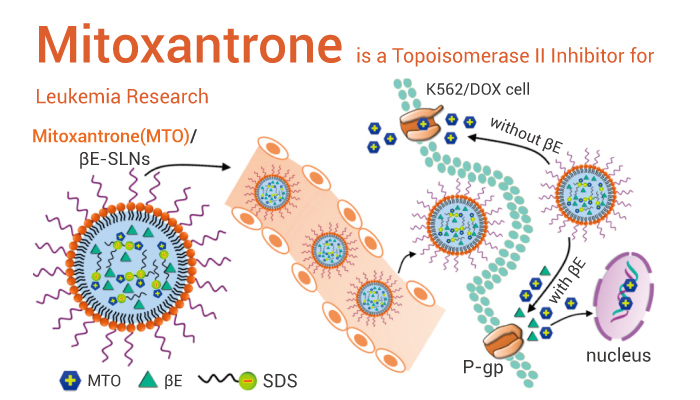Chronic lymphocytic leukemia (CLL) is the most common type of leukemia, which defined as a minimum of 5 × 109/L monoclonal B cells in the blood. However, CLL affects approximately 200,000 people in the US, and represents 1.1% of all new cancers diagnosed in the US. In addition, the median age at diagnosis is 70 years, with a slight male predominance (1.7:1). Moreover, in 2022, it was estimated that approximately 20160 people would be newly diagnosed with CLL and that approximately 4410 patients with a CLL diagnosis would die in the US. Hence, we will introduce Mitoxantrone, a potent topoisomerase II inhibitor, which shows good activity to anti-cancer, including CLL.
Mitoxantrone is a Topoisomerase II Inhibitor and protein kinase C (PKC) Inhibitor (IC50=8.5 μM).
In vitro, Mitoxantrone (0.5 μg/mL, 48 h) induces a decrease in B-CLL cells. Mitoxantrone induces DNA fragmentation and the proteolytic cleavage of poly (ADP-ribose) polymerase (PARP), demonstrating that the cytotoxic effect of Mitoxantrone is due to induction of apoptosis. Moreover, Mitoxantrone shows cytotoxicity to human breast carcinoma cell lines MDA-MB-231 and MCF-7 with IC50 values of 18 and 196 nM, respectively. Besides, Mitoxantrone inhibits PKC in a competitive manner with respect to histone H1, and its Ki value is 6.3 μM and in a non-competitive manner with respect to phosphatidylserine and ATP.
In vivo, Mitoxantrone (i.p.; 0-3.2 mg/kg/day) produces a statistically significant number of 60-day survivors at 1.6 mg/kg in mice with IP implanted L1210 leukemia. In addition, Mitoxantrone (i.v.; 0-3.2 mg/kg/day) shows effective antitumor activities and produces a 60% ILS (increase in lifespan) at 3.2 mg/kg in SC implanted Lewis lung carcinoma.
A in all, Mitoxantrone is a promising dual topoisomerase II/PKC inhibitor for research of cancer (such as CLL) and virus infection (such as anti-cowpox and anti-monkeypox).
Reference:
[1] Shadman M. JAMA. 2023 Mar 21;329(11):918-932.
[2] Takeuchi N, et al. J Biochem. 1992 Dec;112(6):762-7.
[3] Bellosillo B, et al. Br J Haematol. 1998 Jan;100(1):142-6.
